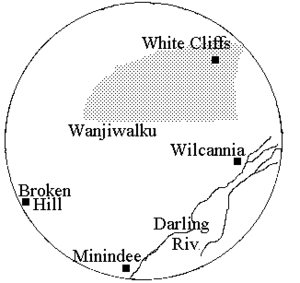Wanjiwalku facts for kids
The Wanjiwalku were an Indigenous Australian group. They lived in the state of New South Wales. They are also known as an Aboriginal people.
Contents
Wanjiwalku Language
The Wanjiwalku people spoke a special language. It was a dialect of the Paakantyi language. A dialect is like a different version of a language. It has its own unique words and sounds.
A researcher named Norman Tindale studied the Wanjiwalku language. He worked with a person named George Dutton. Tindale thought the Wanjiwalku and their neighbours, the Malyangapa people, spoke the same dialect.
Later, other language experts, Luise Hercus and Peter Austin, did more studies. They found that Wanjiwalku was indeed a dialect of Paakantyi. They also learned that the Malyangapa language was very similar to the language of the Yardliyawara people. It was part of the Yarli language group.
Traditional Lands
The Wanjiwalku people lived on a large area of land. Experts believe their traditional country was about 8,000 square miles (21,000 square kilometres). This land stretched from near Milparinka to White Cliffs. It went east from Mount Arrowsmith to the area near Tongo Lake. Their lands also included Yancannia and the area east of Lake Bancannia.
The environment in the Wanjiwalku lands could be very challenging. An early explorer, Charles Sturt, travelled through this area in 1845. He described it as a very difficult place to live. He even had to live underground to escape the extreme heat. Today, parts of this land are used for sheep farming.
Other Names for Wanjiwalku
The Wanjiwalku people were also known by several other names:
- Weyneubulkoo
- Wonipalku
- Wanyabalku
- Wonjimalku
- Pono
- Pernowie, Pernowrie
- Kongait
- Tongaranka
Some Wanjiwalku Words
Here are a few words from the Wanjiwalku language:
- chukeroo (kangaroo)
- koonai (tame dog)
- thirita (wild dog)
- kooma (father)
- ngumma (mother)
- birre-birre (white man)
See also


